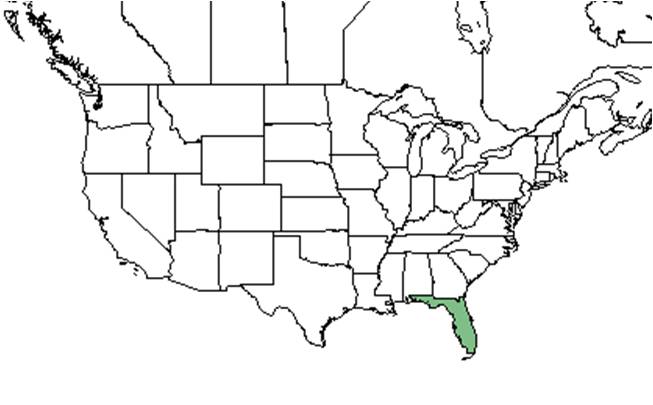Difference between revisions of "Quercus inopina"
KatieMccoy (talk | contribs) |
KatieMccoy (talk | contribs) |
||
| Line 29: | Line 29: | ||
==Ecology== | ==Ecology== | ||
===Habitat=== <!--Natural communities, human disturbed habitats, topography, hydrology, soils, light, fire regime requirements for removal of competition, etc.--> | ===Habitat=== <!--Natural communities, human disturbed habitats, topography, hydrology, soils, light, fire regime requirements for removal of competition, etc.--> | ||
| − | Habitats of ''Q. inopina'' include sand pine-evergreen scrubs, dry slash pine flatwoods, and longleaf pine/scrub oak communities in central Florida<ref name="fsu"/>. Associated species include ''Quercus chapmanii, Q. geminata, Q. myrtifolia, Fraxinus floridana, Ilex arenicola'', and ''Persea humilis''. | + | Habitats of ''Q. inopina'' include sand pine-evergreen scrubs, dry slash pine flatwoods, and longleaf pine/scrub oak communities in central Florida<ref name="fsu"/>. Associated species include ''Quercus chapmanii, Q. geminata, Q. myrtifolia, Fraxinus floridana, Ilex arenicola'', and ''Persea humilis''. It composes 30 to 40% of the cover in scrubby flatwoods<ref name="johnson">Johnson, A. F. and W. G. Abrahamson (2002). "Stem Turnover in the Rhizomatous Scrub Oak, Quercus Inopina, from South-Central Florida." The American Midland Naturalist 147(2): 237-246.</ref>. |
===Phenology=== <!--Timing off flowering, fruiting, seed dispersal, and environmental triggers. Cite PanFlora website if appropriate: http://www.gilnelson.com/PanFlora/ --> | ===Phenology=== <!--Timing off flowering, fruiting, seed dispersal, and environmental triggers. Cite PanFlora website if appropriate: http://www.gilnelson.com/PanFlora/ --> | ||
Revision as of 20:15, 10 March 2016
| Quercus inopina | |
|---|---|
Error creating thumbnail: Unable to save thumbnail to destination
| |
| Photo by Mark A. Garland, hosted by the USDA-NRCS PLANTS Database | |
| Scientific classification | |
| Kingdom: | Plantae |
| Division: | Magnoliophyta - Flowering plants |
| Class: | Magnoliopsida – Dicotyledons |
| Order: | Fagales |
| Family: | Fagaceae |
| Genus: | Quercus |
| Species: | Q. inopina |
| Binomial name | |
| Quercus inopina Ashe | |

| |
| Natural range of Quercus inopina from USDA NRCS Plants Database. | |
Common name: sandhill oak
Contents
Taxonomic notes
Description
A description of Quercus inopina is provided in The Flora of North America.
Distribution
Q. inopina is endemic to Florida, in the xeric, nutrient poor sands of ancient dunes[1].
Ecology
Habitat
Habitats of Q. inopina include sand pine-evergreen scrubs, dry slash pine flatwoods, and longleaf pine/scrub oak communities in central Florida[2]. Associated species include Quercus chapmanii, Q. geminata, Q. myrtifolia, Fraxinus floridana, Ilex arenicola, and Persea humilis. It composes 30 to 40% of the cover in scrubby flatwoods[3].
Phenology
It has been observed flowering in April and fruiting in August (FSU Herbarium).
Seed dispersal
Seed bank and germination
Fire ecology
Pollination
The following Hymenoptera families and species were observed visiting flowers of Quercus inopina at Archbold Biological Station (Deyrup 2015):
Apidae: Apis mellifera, Bombus impatiens
Colletidae: Colletes brimleyi
Use by animals
Diseases and parasites
Conservation and Management
Cultivation and restoration
Photo Gallery
References and notes
Deyrup, M.A. and N.D. 2015. Database of observations of Hymenoptera visitations to flowers of plants on Archbold Biological Station, Florida, USA.
Florida State University Robert K. Godfrey Herbarium database. URL: http://herbarium.bio.fsu.edu. Last accessed: November 2015. Collectors: Loran C. Anderson, H.S. Conard, Robert K. Godfrey, Ann F. Johnson, John G. Rae. States and Counties: Alabama: Baldwin. Florida: Highlands, Manatee, Martin, Osceola, Polk, St. Lucie. Compiled by Tall Timbers Research Station and Land Conservancy.
- ↑ [[1]]Encyclopedia of Life. Accessed: March 7, 2016
- ↑ Cite error: Invalid
<ref>tag; no text was provided for refs namedfsu - ↑ Johnson, A. F. and W. G. Abrahamson (2002). "Stem Turnover in the Rhizomatous Scrub Oak, Quercus Inopina, from South-Central Florida." The American Midland Naturalist 147(2): 237-246.